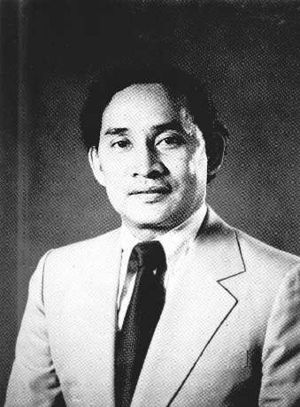Carlos S. Camacho facts for kids
Quick facts for kids
Carlos Camacho
|
|
|---|---|
 |
|
| 1st Governor of the Northern Mariana Islands | |
| In office January 9, 1978 – January 11, 1982 |
|
| Lieutenant | Francisco Ada |
| Preceded by | Erwin Canham (Resident Commissioner) |
| Succeeded by | Pedro Tenorio |
| Personal details | |
| Born |
Carlos Sablan Camacho
February 27, 1937 Saipan, Mariana Islands, South Pacific Mandate |
| Political party | Democratic |
| Spouse | Lourdes Camacho |
| Education | Fiji School of Medicine (MBBS) University of Hawaiʻi (MPH) |
Carlos Sablan Camacho was born on February 27, 1937. He is a politician from the Northern Mariana Islands. He made history by becoming the very first governor of the Northern Mariana Islands. He served in this important role from January 9, 1978, to January 11, 1982.
Contents
Early Life and School Days
Carlos was one of eleven children born to Luis Taimanao Camacho and Ramona Reyes Sablan. He grew up and went to school on Saipan. Later, he was chosen to attend the Pacific Islands Central School in Truk.
After finishing high school, Carlos went to the Fiji School of Medicine. There, he studied basic medicine and dentistry. This education helped him prepare for a career in healthcare.
His Career Journey
Carlos Camacho worked as a doctor until 1967. That year, he was elected to the Congress of Micronesia. This was a big step into public service.
From 1969 to 1977, he served as the chief medical officer for public health in the Pacific islands. This meant he was in charge of making sure people stayed healthy. He was also the president of the Saipan Democratic Party from 1975 to 1977. In 1976, he was chosen to be part of the Northern Marianas Constitutional Convention. This group helped write important rules for the islands. Dr. Camacho is married to Lourdes Camacho, and they have seven children.
Becoming Governor
On December 10, 1977, Carlos Camacho won an election to become the first elected Governor of the Northern Mariana Islands. He beat Jose C. Tenorio, a businessman who was running for the Republican Party. It was a very close election!
Carlos Camacho officially became governor on January 9, 1978. He served one term, which lasted from 1978 to 1982. In 1981, when it was time for the next election, there was a disagreement within his own party. Carlos Camacho and Senator Herman Rogolifoi Guerrero both wanted to be the Democratic candidate. After a court case, Senator Guerrero was named the official Democratic candidate.
Because of this, Carlos Camacho started a new political group called the Commonwealth Popular Democratic Party. He still wanted to run for governor. His running mate was Lorenzo Deleon Guerrero Cabrera. In the election that year, Carlos Camacho lost to Pedro Tenorio, who was the Republican candidate. Camacho finished second in the race.
A Lawsuit: Taisacan v. Camacho
In 1980, the Northern Mariana Islands legislature planned to spend over $1.5 million of federal money. This money was for improvements on the island of Rota. Governor Camacho disagreed and stopped this part of the budget. He thought it was too much money and not fair to other islands.
A person from Rota named Leon Taisacan sued Governor Camacho. He said that the governor's action went against the agreement between the United States and the Northern Mariana Islands. A court first sided with Governor Camacho. Later, a higher court dismissed the lawsuit. They said that Taisacan could not sue because he was not directly harmed by the governor's decision.
After Being Governor
After his time as governor, Carlos Camacho rejoined the Democratic Party. This happened on August 27, 1982, when the Democratic Party and his new party joined together again.
In 1985, Carlos Camacho ran for governor again as the Democratic candidate. He faced Pedro Tenorio once more, but he lost the election. In 1995, he was elected to the Constitutional Convention again. During this convention, he led the group from Saipan and also chaired the Legal Subcommittee. He almost became the president of the convention, losing by just one vote.

